HOME >>
Tracked for success: China to take high-speed rail abroad
Source:Globaltimes.cn Published: 2013-11-28 17:50:00
| Latest News |
Chinese Premier Li Keqiang on November 26 championed the nation's high-speed rail technologies at an economic and trade forum between China and Central and Eastern European (CEE) countries in the Romanian capital of Bucharest.
China, Hungary, Serbia reach agreement on railway project
Chinese Premier Li Keqiang said on November 25 in Bucharest that his country has reached an agreement with Hungary and Serbia to jointly build a railway between the latter two countries.
High-speed progress
After rapid development of China's high-speed railway technology in recent years, the country is hoping to export its expertise in the area to Thailand.
Chinese high-speed trains venture overseas
Parallel to the development of domestic high-speed rail, the Chinese government and rail enterprises are actively seeking customers overseas.
China-Thailand railway cooperation to boost regional interconnectivity: Premier Li
Chinese Premier Li Keqiang said on October 12 that enhancing China-Thailand railway cooperation would bolster regional interconnectivity and benefit the two nations and the reigon at large.
| Go abroad |
| To Romania | |
 |
Achivement: Nov. 2013 China to help Romania high-speed rail China Premier Li Keqiang and his Romania counterpart Victor Ponta agreed on November 25 that their two countries would cooperate in building high-speed railways in Romania. |
| To Thailand | |
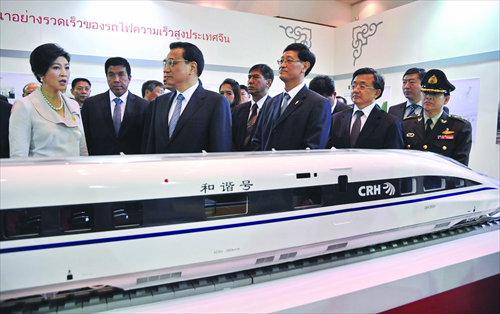 |
Hi-speed rail development 'new highlight' in China-Thailand strategic cooperation China's potential participation in Thailand's high-speed railway project will become a "new highlight" of the two countries' strategic cooperation, as it will further boost economic and trade cooperation, strengthen bilateral ties and enhance regional connectivity. Achivement: Oct. 2010 China links world with its high-speed rail technology In October of 2010, Thailand approved a negotiation framework for a project for Thailand-China cooperation on high-speed rail. Under the framework, the two countries will cooperate to build five railways designed for speeds of 250 km per hour at a cost of $22.5 to $25.5 billion. China, Thailand to co-build high-speed rail Thailand and China have decided to cooperate in three railway projects. The three new railways will link Nong Khai to Bangkok, Thailand, Bangkok to Rayong and Bangkok to Padang Besar in Malaysia. The high-speed railway will be connected with the Mekong area railway network forming a bridge between between Kun Ming in China and Malaysia.The project will occur between 2010 to 2014. |
| To Laos | |
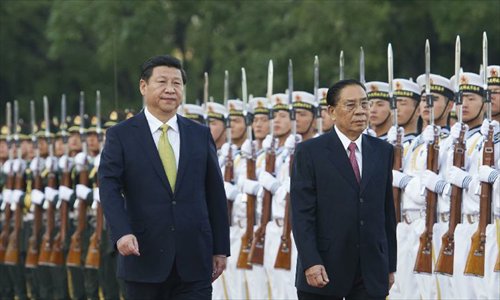 |
Achivement: Apr. 2010 High-speed rail to connect China with Thailand, Laos Deputy Prime Minister of Laos Somsavat Lengsavad told the Congress that based on the agreement with China the high-speed railway linking the Lao capital Vientiane with Beijing will begin construction in 2011 and be completed in 2015. Bilateral trade between China and Laos grew by more than half in 2009 to $751.8 million. China links world with its high-speed rail technology In April of 2010, Laos reached an agreement with China to establish a joint venture that will construct a railway linking China's southwestern Yunnan province and the Lao capital of Vientiane. The project will be launched in 2011, with an estimated construction time of four years, Lengsavad said. |
| With US | |
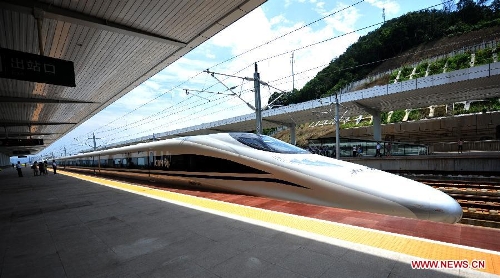 |
Achivement: Nov. 2009 In November, 2009, US General Electric Company signed a memorandum with China’s Ministry of Railways. |
| With Russia | |
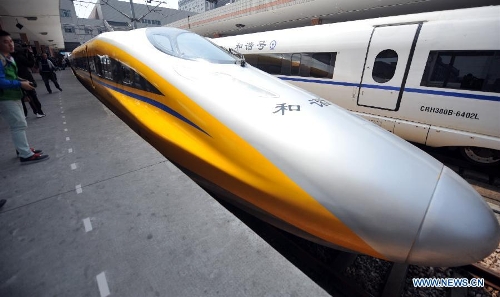 |
Achivement: Oct. 2009 China's Ministry of Transport signed a memorandum of understanding with its Russian counterpart in October 2009 to share its high-speed railway technologies. Russia and China are also studying construction of a high-speed line connecting Beijing and London as part of a trans-Eurasian transport corridor. |
| Graphics |
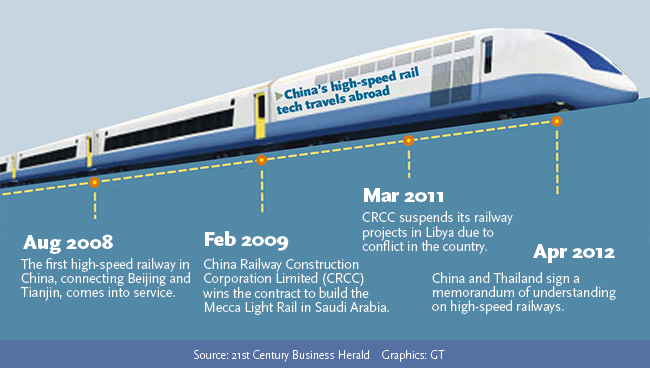
| Development |
| 2004 | The State Council, China's cabinet, approved the Medium and Long-term Plan for Railway Network.The start of China's development of high-speed railways --railroads capable of accommodating trains with a traveling speed of 200 km per hour and beyond. |
| Apr. 18, 2007 | High-speed trains traveled for the first time, when bullet trains running at 200-250 km per hour were put to use on several tracks, including the Beijing-Harbin, the Beijing-Shanghai and the Beijing-Guangzhou lines. |
| Apr. 18, 2008 | construction started on the Beijing-Shanghai High-speed Railway. According to designs, trains on the line will have a top operational speed of 380 km per hour, and the entire journey, extending 1,318 km, will take just four hours. |
| Aug. 1, 2008 | The country's first high-speed railway, linking the Chinese capital Beijing and the neighboring port city Tianjin, was inaugurated, with trains traveling at a speed that could reach 350 km per hour. |
| Oct. 31, 2008 | An adjusted version of the Medium and Long-term Plan for Railway Network came into effect. According to the plan, the total operation mileage of the country's express passenger railways will exceed 50,000 km by 2020, covering almost all Chinese cities with a population of 500,000 or above. |
| Dec. 26, 2009 | The 1,069 km-long Wuhan-Guangzhou high-speed railway was put into service. It was China's first long-distance high-speed rail track. |
| Jul. 1, 2010 | The Shanghai-Nanjing Intercity High-speed Railway opened. The high-speed line is believed to be the shortest of its kind in China with the most number of stops. |
| Dec. 3, 2010 | A CRH-380A train set a new speed record of 486.1 km per hour on a test run on the 1,318-km Beijing-Shanghai high-speed railway, which officially started operation on June 30, 2011. |
| Jul. 23, 2011 | A high-speed train slammed into a stalled train near the eastern city of Wenzhou, resulting in 40 deaths and 172 people being injured. The accident, which was blamed on faulty signaling equipment and mismanagement, led to a nationwide rail safety check, speed reduction for bullet trains and stagnation in high-speed rail construction. |
| Mar. 2012 | The State Council adopted the 12th five-year plan for transportation system development, which plans for more than 40,000 km of express railways by the end of 2015. |
| Sep. 2013 | China had nearly 10,000 km of high-speed railway lines in operation and had solved technical challenges on various complex geographical problems. |
Source: The development of China's high-speed rail network
Backgrounder: China's high-speed rail development
| Other diplomacies |
| 'Ping-pong' diplomacy | |
 |
On April 10,1971, the US national table tennis team, along with a group of journalists, became the first US sports delegation to set foot in China since 1949. The Chinese table tennis team made a reciprocal trip to the US in the following April, two months after a visit to Beijing by then US President Richard Nixon. Meaning: The ping pong games marked a thaw in then-strained China-US relations, paving the way for the normalization of their ties. |
| Pandas diplomacy | |
 |
In 20 centry, China's "Panda diplomacy" started from 1950s. From 1957 to 1982, China presented 23 pandas as gifts to nine countries. China stopped offering pandas as gifts to foreign countries amid a sharp decline in the panda population in the early 1980s. It set up a loan system in 1984 under which foreign zoos can house pairs of bears in the captive breeding program. Pandas are now leased out for joint research. Meaning: Giant pandas have been serving as successful cultural ambassadors bridging China and other countries. People around the world host pandas out of passion for the tubby bears. |
| Commentary |
High-speed train technology supports diplomatic efforts
To strengthen China's high-end manufacturing industry's competitiveness, China needs to build its brands. Perhaps the high-speed railway is the very point to make the breakthrough. Premier Li's introduction of China's high-speed railways overseas is a strong incentive and solid backing to China's manufacturing industry.
High-speed rail can take slower approach in risky overseas markets
China should be aware that unpractical plans and requirements demanded by importers will prove troublesome, and participation in the competition at the right time will produce more reciprocal results than blindly meeting the requirements of importers.
High-speed rail: New Silk Road
The international rail network will boost the exchange of trade and promote China's newly acquired high-speed railway technology, likely the next brand of "Made in China" comparable to world competitors, experts say.
Xinhua:
China's high-speed rail ready for export
As the Chinese high-speed railway network grows, it is high time that China exported its technology and expertise, probably starting with neighboring countries, where its advantages are suited to developing nations and will speed up progress.
Chinese high-speed trains venture overseas
Li Hongchang, railway expert and economics professor from Beijing Jiaotong University, said high-speed rail "going abroad" is anything but simple. It involves juggling trade, finance and energy concerns and requires efforts from governments on both sides, Li said.
Hong Kong Economic Times:
High-speed railways a new diplomacy for China
China and Thailand are furthering cooperation in politics, economics, culture and many other areas. High-speed railway projects are playing an increasingly important role in China’s diplomacy, much like ping-pong diplomacy and panda diplomacy in the past.
| Related News |
China's high-speed rail expands ticket discount
China rewrites global high-speed rail pattern in six years
China seeks to restore confidence in high-speed trains
The end of the line
World's longest high-speed rail line makes debut
China links world with its high-speed rail technology
Web editor: wangnan1@globaltimes.com.cn
Posted in: